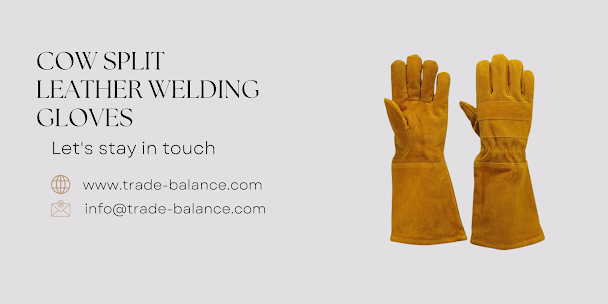Search This Blog
Trade Balance is a leading Goods inspection and audit service provider based in Pakistan. We ensure quality and compliance for businesses through meticulous inspection processes, safeguarding their trade interests and promoting reliability in the market. Email:info@trade-balance.com www.trade-balance.com
Trade balance
- Get link
- X
- Other Apps
LEATHER WELDING GLOVES
LEATHER WELDING GLOVES
Introduction to Welding Gloves
Welding is a skilled profession that requires specialized equipment to ensure safety and efficiency. One of the most important pieces of personal protective equipment (PPE) for welders is a good pair of welding gloves. Welding gloves are designed to protect the welder's hands from heat, sparks, and other hazards associated with the welding process.
Welding gloves come in a variety of materials, including leather, cowhide, goatskin, and even synthetic materials like Kevlar. Each type of welding glove has its own unique properties and is suited for different welding applications.
In this blog post, we will explore the different types of welding gloves, their uses, and the benefits of using genuine leather welding gloves made from goat and cow skin.
Types of Welding Gloves
1. TIG Welding Gloves
TIG (Tungsten Inert Gas) welding is a precise and controlled welding process that requires a high level of dexterity and control. TIG welding gloves are designed to provide a snug fit and excellent tactile feedback, allowing the welder to manipulate the welding torch and filler rod with precision.
TIG welding gloves are typically made from lightweight and flexible materials like goatskin or thin cowhide. They often feature a reinforced palm and fingers for added durability and protection against heat and sparks.
These gloves are made from premium goatskin leather and feature a reinforced palm and fingers for added protection. The gloves also have a snug fit and excellent dexterity, making them ideal for TIG welding applications.
2. MIG Welding Gloves
MIG (Metal Inert Gas) welding is a more common and versatile welding process that is often used for thicker materials and larger projects. MIG welding gloves are designed to provide a balance of protection and dexterity, allowing the welder to work efficiently while still being protected from the hazards of the welding process.
MIG welding gloves are typically made from thicker and more durable materials like cowhide or a combination of cowhide and split leather. They often feature a reinforced palm and fingers for added protection against heat and sparks, as well as a longer cuff for added coverage of the forearm.
These gloves are made from premium cowhide leather and feature a reinforced palm and fingers for added protection. The gloves also have a longer cuff for added coverage of the forearm and a snug fit for improved dexterity.
3. Stick Welding Gloves
Stick welding, also known as shielded metal arc welding (SMAW), is a welding process that uses a consumable electrode coated in flux to lay the weld. Stick welding gloves are designed to provide a balance of protection and dexterity, allowing the welder to work efficiently while still being protected from the hazards of the welding process.
Stick welding gloves are typically made from thicker and more durable materials like cowhide or a combination of cowhide and split leather. They often feature a reinforced palm and fingers for added protection against heat and sparks, as well as a longer cuff for added coverage of the forearm.
These gloves are made from premium cowhide leather and feature a reinforced palm and fingers for added protection. The gloves also have a longer cuff for added coverage of the forearm and a snug fit for improved dexterity.
4. Plasma Cutting Gloves
Plasma cutting is a process that uses a high-velocity jet of hot plasma to cut through metal. Plasma cutting gloves are designed to provide protection against the intense heat and sparks generated by the plasma cutting process.
Plasma cutting gloves are typically made from thicker and more durable materials like cowhide or a combination of cowhide and split leather. They often feature a reinforced palm and fingers for added protection against heat and sparks, as well as a longer cuff for added coverage of the forearm.
These gloves are made from premium cowhide leather and feature a reinforced palm and fingers for added protection. The gloves also have a longer cuff for added coverage of the forearm and a snug fit for improved dexterity.
Benefits of Genuine Leather Welding Gloves
Genuine leather welding gloves offer a number of benefits over other types of welding gloves, including:
Durability
Flexibility
Genuine leather is a flexible material that allows for a high degree of dexterity and control. Leather welding gloves are designed to conform to the shape of the welder's hand, providing a snug and comfortable fit that allows for precise manipulation of welding tools and equipment.
Customization
Goatskin vs. Cowhide Welding Gloves
Goatskin Welding Gloves
Cowhide Welding Gloves
Choosing the Right Welding Gloves
- Level of dexterity required
- Degree of heat exposure
- Potential for sparks and abrasions
- Comfort and breathability

.png)
.jpg)



Comments
Post a Comment